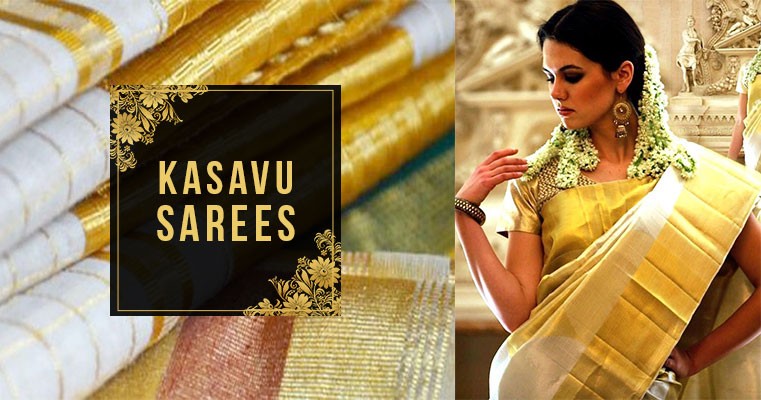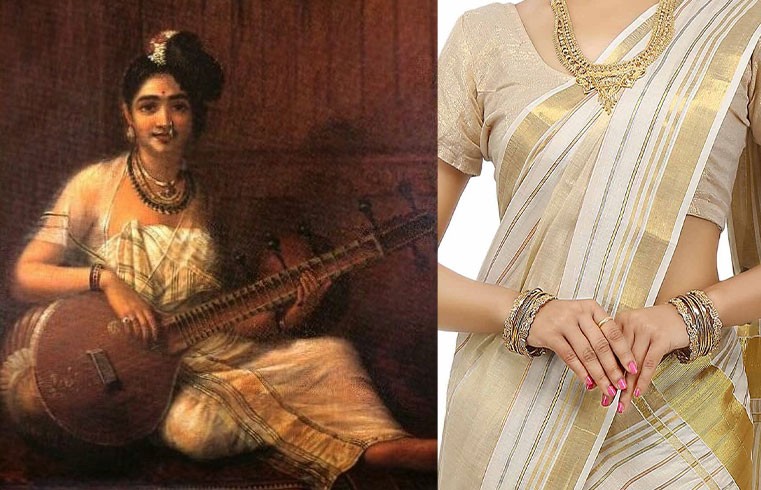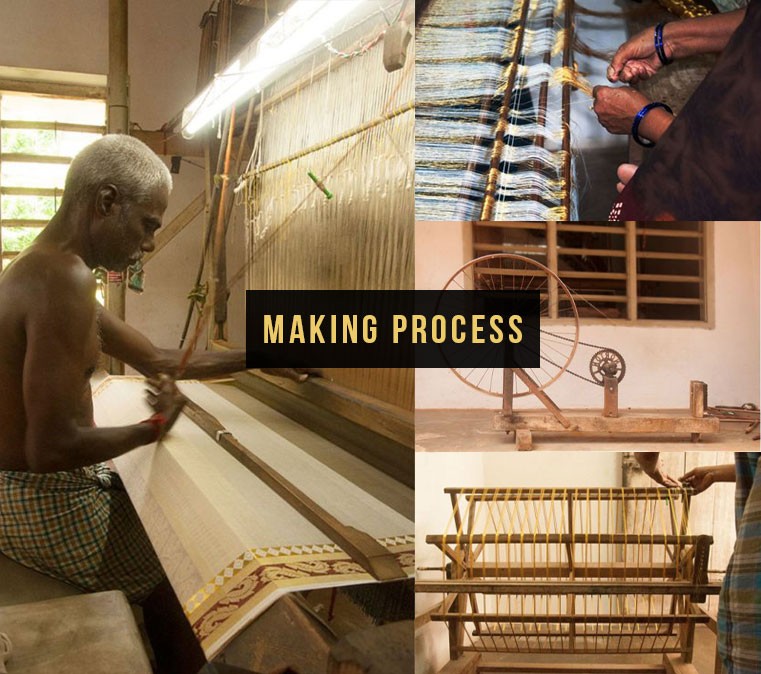A Rich Heritage of Culture, Luxury and Opulence: The Kasavu sarees

A Kasavu saree is a popular Kerala saree which is a single piece of cloth woven by the traditional artisans of Mysore. A Kasavu is name given to the golden thread with which the border of Kerala Saree is made. These sarees are typically golden and white in colour.
History: A walk down the memory lane
Though kasavu saree is the festive Kerala saree and is rooted deep in tradition and culture of the people. Women wore mundu. Which is a garment that started at the waist and continued below. Post-colonization women chose to wear angavastra to cover their upper body, which was transformed to form the settu mundu. Settu Mundu was also called ‘mundum neriyathum’.

With time, women wore one mundu below the waist and another above it to cover their full body. And after some time, women started using half sarees or kasavu sarees were made for the royals.
In Kerela, a collective name given to traditional attire is called Kaithari, which includes sarees, mundus and sethu mundus. The Government of India has awarded Geographical Indication (GI) tag for these Kasavu sarees to three clusters in Kerela- Balaramapuram, Chendamangalam and Kuthampully.
Tools used in Kasavu saree making process
- Small Bobbins: It is used to wind up the fine and silky zari thread work for the warping process.
- Safety Pins: It is used to hold the printed fabric for drying firmly
- Charaka Equipment: It is used to wind the yarn
- Rice Kanji: This is the liquid where balls of cotton yarns are dipped to make them stiff and sturdy
- : It is used to cut extra yarns.
- Sticker Gum: It is used to stick the fabric firmly during the printing process
- Measuring Tape: It's used to determine the fabric's length and width.
- Chalk Powder: This is what is applied to the table which is used for making the next printing for the saree
- A small piece of fabric: It is intended to adhere to the printing table's two edges.
- Sand Paper: It's used to massage the fly shuttle's corners for a finer weaving process.
Making process

Cotton balls of yarn are brought from Salem (Tamil Nadu) and zari threads from Gujrat. Here these balls of yarn are wound into pirns by using Charaka equipment and then immersed in the Kanji liquid to make it stiff. Cotton yarns are laid out on the beam, knotted together with prior cotton yarn, and secured to the loom. For the weft, Zari threads are wound to pirns using Charaka machinery. Zari bobbins are fed into the Zari warping beam, which features eyelets that move from one end to the other as the length is wound. For a greater grip, the Zari threads are knotted firmly to the prior threads and treated with wax along the length.
These cotton yarns and zari threads are set into the loom, and the weaving is completed using the jacquard's regulated mechanism for pattern work insertions. This saree is further taken for printing and embroidery purposes. These kasavu sarees are woven nicely on the power looms of Erode and Salem which is further textured to form fine prints which is the primary seal of every saree woven in the lands of Kuthampully. To make further designs on the saree, it is 1st adhered to the table using the two ends of the saree by using sticker gum and designs are made using chalk powder similar to block printing. This printing paste is scattered through the screens to all the saree pieces according to the requirement of the design and the colour. The saree is next calendared, which entails running it through a series of rollers to get a smooth finish and refined texture.
Some facts about Kasavu Sarees
Minimalist Pattern
The Kerala saree is of the minimalistic pattern where the only attraction is the border and the plain weave. The golden border is the main attraction of this subtle saree. Because of its rich culture, it is a popular gift item among people and is only worn during special events. The gold border used is of premium quality and thus adds more poise to the simple plain drape.
Why all sarees are neutrally coloured?
Well, there is no definite reason but some argue that there is so much colour in Kerala the saree rarely needs one. Some of the researchers have argued that there is so much rain in Kerala, that dying is a difficult process to do so. And some historians have concluded that a lot of adornment comes from wearing gold jewellery, there is no point in making them patterned.
Why kasavu saree is considered important?
In the olden days, patterning was taken as a crime. And these kinds of rich and luxurious kasavu sarees were worn by the VIPs or by the posh people who generally wore kasavu sarees to the events and commoners wore colourful sarees.
How much time does it take to weave a kasavu saree?
Technically this saree has minimal designs and patterns, so it does not take much time. But recently, one could spot patterned designs, motifs like trees, excerpts from Onam culture, hand inlays, jacquards to give a more mainstream theme to it.
Whether it is a golden border or a silver border, every piece of this gorgeous kasavu saree is made by the talented artisans of Kerala to make you look gorgeous.
Latest Posts
Categories
Tags


 080-69544000
080-69544000














